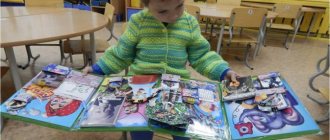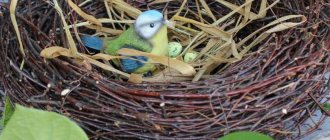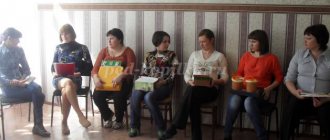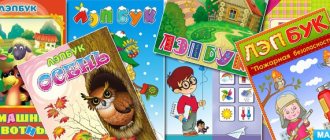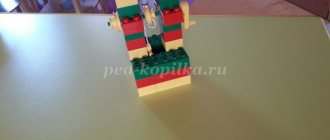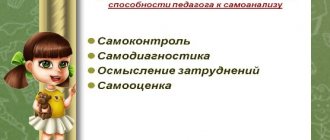Lapbook on the topic: “Pets and birds” for kindergarten with your own hands
Lapbook on the topic: “Pets and poultry” for preschool children
Author: Olga Nikolaevna Ryazanova, teacher Description of work: this material will be useful for educators, parents and people who want to try something new with their children. Purpose: The lapbook is intended to familiarize and expand children's knowledge about domestic animals. In this manual, you can collect and expand material, create new sections, and insert children’s creative works. Goal: making a lapbook on the topic of pets. Tasks: • select material for the topic; • produce printed board games; • create a laptop; • develop interest in this type of work.
We will need: • ring binder; • colored paper; • glue, brush, scissors; • plastic envelopes; • Double-sided tape; • Internet resources.
Completing the work: 1. I took a ring binder as a basis. I covered the front of the folder and the end with colored paper and wrote an inscription. 2. I prepared bookmarks with various headings: • interesting facts; • verbal and didactic games; • puzzles; • literary works; • Proverbs and sayings. The content can always be replenished and new sections can be introduced.
3. I found the necessary material for each section on the Internet.
For colorfulness and accessibility, on the first page, I inserted a picture with this pet (bird). Each section was designated by a “separator.” 4. I laminated the printed board games and put them in plastic envelopes, which I then attached with double-sided tape to the walls of the folder. Since there could be a lot of games, some of them were inserted into the files in the section “Verbal and didactic games”
. All games are laminated, so they will last a long time. And when children learn to read, they will be able to use the works included in the corresponding section themselves.
Section contents:
Interesting Facts
Camel A tired camel wanders through the desert.
He wants water, but he can’t find it. As the sun is blazing, there is not a cloud in the sky. And underfoot there is sand and thorns. Camels played a significant role in the life of the nomadic peoples of the East.
They were used as pack, draft and riding animals. Nomads found their way in the sands only thanks to the instinct of camels. It happened that nomads satisfied their severe hunger by cutting pieces of fat from the humps of camels. But upon the caravan’s arrival at its destination, the camel drivers gave the camels a royal rest. They gave them plenty of food and drink, and treated them to tobacco and tea leaves. Camels bring great benefits to people. It is customary to eat camel meat; cheese and butter are made from camel milk; make fabrics from wool. Even droppings were used as fuel. The Arabs call camels “ships of the desert.” Indeed, camels are capable of walking 100 km a day, carrying luggage weighing 200–300 kg on their backs. The genus of camels includes two species - the two-humped camel, or Bactrian, and the one-humped camel, or dromedary. They were domesticated about 5 thousand years ago. It is believed that there are only about 300 wild Bactrians left. They live in the southwest of Mongolia, in the Gobi Desert. These are large animals, up to 2.5 m high and weighing about 700 kg. The horse is racing across the steppe, give way to it.
And the camel thought: “I won’t gallop after her.” Yu. Parfenov Bactrian camels are perfectly adapted to living in desert areas.
They have excellent vision. Visual memory helps to navigate in the desert, a keen sense of smell helps to sense water several tens of kilometers away. Camels feed mainly on tough shoots of saxaul and camel thorn. Camels live 35–40 years; once every two years, the female gives birth to one calf. The dromedary camel is slightly smaller than the Bactrian camel, but has longer and slimmer legs. The camel can be called “the most economical animal.” His body is ideally adapted to retain moisture in hot desert conditions. A camel's body temperature ranges from 34 degrees at night to 40 degrees during the day. At the same time, the camel hardly sweats. Carefully using the moisture contained in the body, a camel, when it gets to a source of water, is able to drink a truly colossal amount of liquid. The “world record” belongs to a camel, which in one sitting absorbed 94 liters of water, and after some time drank another 186 liters. Interesting facts about the goat
1. Goats often chew seemingly inedible objects.
This is not because they are supposedly stupid, but simply because of their natural curiosity - they are interested in tasting everything. 2. One goat can have a herd of 40-50 goats, which he will lead. 3. All currently existing breeds of these animals descended from the wild bezoar goat. This animal is still found in the wild. 4. Goats were one of the first animals domesticated by humans. This happened around the 7th millennium BC. 5. Goats have almost 300 degrees of vision. Their eyes are generally unique, with horizontal rectangular pupils. 6. Goats have almost 300 degrees of vision. Their eyes are generally unique, with horizontal rectangular pupils. 7. According to official statistics, the United States occupies the first place in the world in raising goats. 8. In Morocco, due to a lack of grass, goats climb trees and graze there in whole herds, feasting on the fruits of the argan tree, the nuts of which are used to make fragrant oil. 9. Every year, in the first half of April, goat races are held on the island of Tobago in the state of Trinidad and Tobago, attracting many tourists. This sport has existed since 1925. 10. In Scandinavia, from ancient times to this day, sometimes a head of garlic is hung on the neck of goats to protect them from trolls. 11. In the film “Mom” based on the fairy tale “The Wolf and the Seven Little Goats” there are only five kids. When filming this Soviet-Romanian-French musical film, the arithmetic average was chosen, since the fairy tale “The Wolf and the Seven Little Goats” is known in Romania as “The Goat and the Three Little Goats.” 12. Goats are born with teeth. They have no teeth in the upper jaw. Instead, the hard dental cushion acts like teeth. 13. They have excellent memory: they learn very quickly and have long-term memory. Responsive and able to solve simple logic problems. Puzzles
Goat
Not a cow, but with horns: “Who am I?” – find out for yourself. I also chew grass, I also give milk, I wake up early in the morning, I go to the meadow, I graze there until the evening, Well, what’s my name? *** It gives us milk, although it is not a cow, it is ready to share its wool. She is fidgety and fidgety... What do we call her? … *** Loves to chew grass, maybe give him milk. I even visited a fairy tale and saved my children there. She has horns, she’s always slim - This is our dereza! Answer quickly, what kind of name was given to her? *** Loves to chew grass, maybe give milk. I even visited a fairy tale and saved my children there. She has horns, she’s always slim - This is our dereza! Answer quickly, what kind of name was given to her? And so I select riddles for each pet and bird. If there are, then about each “family member” (rooster, hen, chick; ram, ewe, lamb, etc.). Each page with riddles is accompanied by pictures of a given animal (bird).
List of literature about pets and birds
Pets A. Vvedensky “About the girl Masha, about the dog Cockerel and about the cat Thread” (chapters) V. Dmitriev “Baby and the Bug” (chapters) V. Oseeva “Why” V. Suteev “Who did you say meow? G. Garin - Mikhailovsky “Theme and the Bug” D. R. Kipling “The Cat Walking by itself” E. Charushin “Rabbit”, “Cat” K. Paustovsky “Cat - a Thief” K. Ushinsky “Carrying Cow”, “ Blind Horse" L. N. Tolstoy "Kitten", "Fire Dogs", "Lion and Dog" N. Nosov "Living Hat" S. Marshak "The Tale of a Stupid Mouse", "Mustachioed - Striped" S. Mikhalkov "Puppy" , “Kittens” E. Uspensky “Uncle Fyodor, the Dog and the Cat” Russian folk tales “The Wolf and the Seven Little Goats”, “Sivka the Burka”, “The Fox and the Goat”, “The Cockerel and the Bean Seed” (arranged by O. Kapitsa) “The Three Little Pigs” (translated by S. Mikhalkov) Agnia Barto and Pavel Barto “Whoever reads a book can count to ten” Agnia Barto and Pavel Barto “Do Animals Think” V. Zlotnikov “Jack and I” G. Ball “Early in the Morning” Z .N.Aleksandrova “Kitten” Z. Byadulya “Funny joke about the Duck” translation from Bel. E. Axelrod Y. Akim “Little Fox” V.V. Arbekov “Pie” E. Charushin “What kind of animal?” G. Oster “A Kitten Named Woof.” L.N. Tolstoy “The Lion and the Dog”, “Kitten”. Br. Grimm "The Town Musicians of Bremen". R.s.s. "The wolf and the seven Young goats". Poultry B. Zhitkov “The Brave Duckling” G.-H.
Andersen “The Ugly Duckling” M. Prishvin “Guys and Ducklings” N. Emelyanova “Oksya the Hard Worker” O. Donchenko “Petrus and the Golden Egg” E. Blyton “The Famous Tim Duckling” (chapters) in trans. from English E. Papernoy Russian folk tale “Cockerel” Ukrainian folk tale “Spikelet” Proverbs and sayings
Cat • A kind word is also pleasant for a cat.
• Where there is no cat, there is a mouse frolicking. • If you feel sorry for milk, you won't see the cat. • The cat knows whose meat it has eaten. • The little bird started singing early, as if the cat wouldn’t eat it. • Sly as a cat. • The cat also loves the mouse. • The cat loves fish, but doesn’t want to go into the water. • Don't play with coal, your cat will burn its paw. • Throws a cat in the eye. • The cat will shed the tears of a mouse. Verbal and didactic games
(topic dictionary) Nouns:
animals, cow, calf, horse, foal, pig, piglet, cat, kitten, dog, puppy, goat, kid, sheep, lamb, rabbit, baby rabbit, wool, horns, hooves, muzzle, tail, paws, cowshed, stable, pigsty.
Verbs:
runs, butts, gets sick, bites, eats, walks, caresses, barks, grunts, moos.
Adjectives:
beautiful, fluffy, curly, angry, lively, horned, white, red, domestic, pink, spotted.
Goal: Clarification, expansion, activation, generalization of children's vocabulary. Objectives: 1. Clarify and expand active and passive vocabulary; practice choosing definitions. 2. Develop the ability to solve riddles. 3. Reinforce general concepts. 4. Develop memory, attention, logical thinking. “Who is the most attentive?” Let's compare a cow and a horse. What does a cow have that a horse doesn't? (Horns, udder). What does a horse have that a cow doesn't? (Mane). What animals have horns? Hooves? Claws? Mustache? Guess which animal I wished for. He has legs, hooves, a mane, a tail (a horse). The horse neighs. He's looking for…. This animal has legs, hooves, a tail, and horns. This…. What does a cow call her baby? This animal has legs, hooves, a tail, horns, and fur. This is..... “Whose? Whose? Whose? Whose?" Objectives: 1. develop the ability to form possessive adjectives; 2. consolidate children’s knowledge about domestic animals and poultry; 3. develop attention, visual memory; 4. develop the grammatical structure of speech. Based on the picture, children are asked the question: Whose paw is this? (this is a cat's paw). Whose ears are these? (cat's ears). Whose ear: (dog ear) “Semantic series” Instructions: I will name three words, guess what the fourth will be. 1. bird-nest, dog -…; 2. jacket-fabric, boots-...; 3. horse-foal, cow-...; 4. book cover, house -…; 5. dog - puppy, person -... “Who has whom?” Purpose: using the genitive case of singular and plural nouns. The cat has ... (kitten, kittens). The camel has ... (calf, camels). “Pick up a word” Purpose: to teach children to select and name feature words, action words. Ram (what) ... (horned, bold, curly). Rabbit (what) ... (long-eared, cowardly, timid). The dog (what does it do) ... (howls, runs away, chases, barks). “Name the family” Purpose: to introduce children to the names of domestic animals and birds, their families; develop children's speech. Dad is a bull, mom is ... (cow, baby - ... (calf). “Who is the odd one out?” Objectives: 1. to promote the formation of children’s ideas about domestic animals and birds; 2. to develop the ability to classify, draw conclusions; 3. to develop attention, visual memory; 4. consolidate the general concepts of “pets” and “poultry.” “Fun Counting” Objectives: 1. consolidate knowledge of animals; 2. develop the grammatical structure of speech, learn to coordinate nouns with numerals; 3. develop attention, visual memory. The number of games is constantly growing. "The Fourth Wheel"
“Who eats what?” I cut the pictures, laminated them and use them for other board and printed games. “Gather a Family” These pictures can also be used for other games.
"Scheme - description"
When describing animals and birds, I use cards from games. The children began to make a new section with riddles, using work done in class using non-traditional techniques.
This type of visualization is very interesting for children. All games are laminated, so they will last a long time. This is the laptop I made.
Download Lapbook on the topic: “Pets and poultry” for preschool children
We recommend watching:
Lapbook for kindergarten: Trees on our site: Cherry Lapbook for preschoolers with your own hands Lapbook “Space” for the preparatory group of kindergarten Summary of a lesson on speech development “In the world of animals of hot countries” in the preparatory group (for weak
Similar articles:
A story about the platypus for 1st grade children
A story about a hamster for children of senior preschool age
A story about a crocodile for children in kindergarten
Topic: "Flowers and plants."
Master class for teachers on making laptops.
Goal: To familiarize teachers with the form of work on cognitive, research and creative activities with children “LEPBUK”, aimed at consolidating and systematizing the studied material, increasing children’s interest in learning; development of creative and research abilities; with types and stages of making a laptop.
Tasks:
1. Analyze the form of work “LAPBUK” from the point of view of pedagogical value, based on the topic “Flowers and Plants”.
2. To acquaint teachers with the types and stages of making a laptop, its capabilities in systematizing and structuring information.
3. To increase the level of teachers’ skills in making an interactive folder on the topic: “Flowers and Plants”; maintain a favorable psychological climate, positive attitude, sincerity and openness.
Participants of the master class: those present and participants of the competition.
Materials and equipment: a selection of fiction on the topic, an unusual booklet with encyclopedic data; materials needed to create a lapbook “Flowers and Plants” (glue, gouache, palette, brush, napkins, number puzzles (bee, ladybug), magnifying glass, picture of a bumblebee, algorithm for making fabrics from plants, finished products from cotton, chintz, cotton wool, structure of a flower (picture).
Course of the master class:
- Introductory part.
Dear colleagues, I invite those who wish to take part in my master class. There are envelopes with the task in front of you, please read them. Complete the tasks independently without interfering with each other.
Dear colleagues, do you like flowers? Close your eyes and imagine the most beautiful flower. How did it turn out for you? What does a flower symbolize for you? And in my imagination, flowers symbolize children. As in one popular expression, “children are the flowers of life.”
In the past, teachers were called “gardeners.” They called it because they considered children to be flowers. The work of a teacher can be compared to the work of a gardener; each flower has its own approach. One loves warmth, the other loves coolness, one loves abundant watering, and the other grows beautifully without moisture. Likewise, in the work of a teacher, each child needs an understanding of his personality. Every creative teacher is in constant search for forms, methods and techniques that would allow solving the problems of personality-oriented pedagogy. In this regard, I would like to present to your attention one interesting technique that my colleagues immediately appreciated. First, tell me, do you like secrets?
And remember, that distant amazing feeling when you made discoveries, it is precisely on this love of children for secrets and discoveries that the technology of creating a lapbook is built. What is a lapbook? Lapbook (lapbook) - literally translated from English means “knee book” (lap - knees, book - book). This is a small homemade folder that a child can conveniently lay out on his lap and view all its contents at one time.
The laptop is a relatively new learning tool. Americans were the first to create lapbooks. A laptop is a folding book with pockets, doors, windows, tabs and movable parts, in which materials on one topic are placed. This is a great way to reinforce a certain topic with preschoolers, comprehend the contents of a book, and conduct research work, during which the child participates in searching, analyzing and sorting information.
You may have already heard about this technology, but it is not widespread enough in kindergartens, and deserves special close attention, because it allows you to solve problems like teaching children to systematize and structure information on studying any topic. I think it's better to try once than to hear a hundred times.
2. Main part.
And today I invite you to make this book together. Although it's not that simple. Creating a lapbook is a long process, drawn out over time, but my colleagues came to my aid today and the work will go faster. Each of them has detailed instructions. And we will start with the most important thing, with the title of our future book. It was no coincidence that I began my speech by talking about flowers, because the theme of our lapbook is “Flowers and Plants.” This is a very interesting and extensive topic. Please note that some elements are already present in the book. For example, here is such an interesting gallery, a pocket with a selection of fiction on the topic, an unusual book with encyclopedic data. We became interested in this topic after reading the fairy tale “About how flowers came to Earth” with the children. My first assistant will tell us about the structure of plants - an applique (root, stem, leaves, flower). Please tell me what you did for us?
It's probably hard to find a person who doesn't like flowers. What a variety of colors is presented in any flower bed. How to paint this multi-colored carpet with only 5 colors in your palette. What did you learn today?
— How to get new shades by mixing primary colors: orange, green, purple, blue.
—What have you done for our book? (I made a color mixing chart to get new shades).
- And this scheme takes place in our book.
— What did you do for our book today? (I put together number puzzles in ascending and descending order. In one picture I got a ladybug, and in the other a bumblebee). (addressing the audience)
— Why did these pictures appear here if we are talking about plants? (protect from pests, pollinate) (addressing to the audience)
— Remember what the legs and body of insects look like? What are they covered with?
-The next participant will tell us how pollination occurs. (I took food coloring and a cotton swab, which is as fluffy as the legs of insects, placing the stick first in the dye and then on the flower. I saw that the paint first stuck to the stick and then stayed on the flower. And in the book we put a mixing diagram paints).
-What other types of pollination do you know? (to the audience) (by the wind, self-pollination,...)
-Do you believe that plants can be used in industrial production?
-If you believe, clap, if you don’t believe, stomp. I am making a mat from cotton wool.
—What have you done for our book? (I made a diagram for obtaining tissue from plants).
-Clothes are made from these fabrics. In our lapbook there is such a wardrobe, in which clothes made from different types of fabric obtained from plant materials are stored. This allows you to strengthen word formation skills. For example: a linen skirt? Chintz dress? Linen trousers? Satin apron? Etc.
3. Final part, reflection.
We added so many things to our lapbook. And he's already ready. The technology is universal and designed for creative teachers who are focused on different areas of child development and allows an adult to actively interact with the child in the process of creating such a book
Vasily Aleksandrovich Sukhomlinsky said - “Children should live in a world of beauty, games, fairy tales, music, drawing, fantasy, creativity.” And the teacher’s task is to provide this to the child in preschool childhood. I want to wish you success in this difficult work and I hope that this master class will help you.

